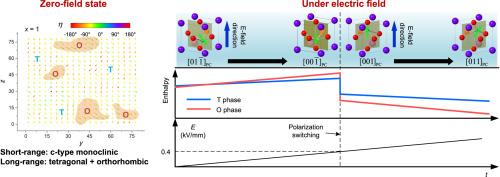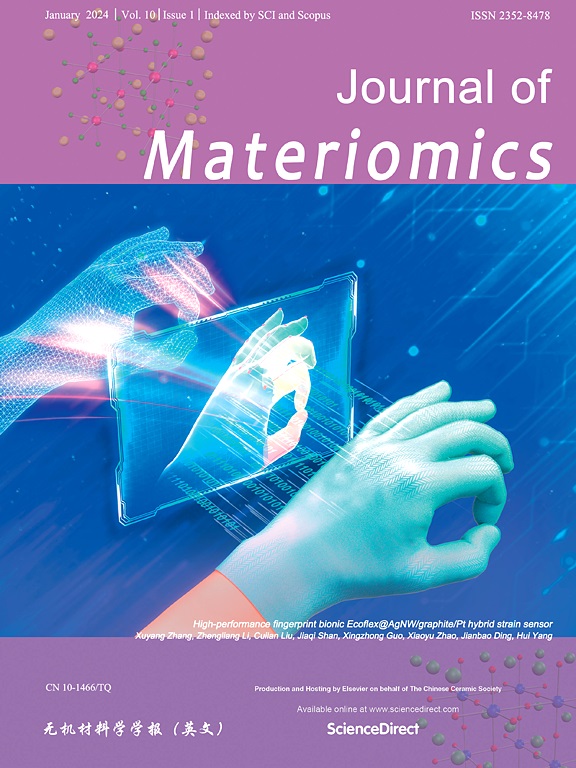Polarization rotation in high-performance KNN-based piezoceramics revealed by an in situ electric field pair distribution function
IF 9.6
1区 材料科学
Q1 CHEMISTRY, PHYSICAL
引用次数: 0
Abstract
Understanding the atomic-scale structural dynamics that enable ultrahigh piezoelectric responses in lead-free piezoceramics remains a central challenge in materials science. Here, we employ in situ electric field pair distribution function (PDF) analysis to elucidate the local structural origin of a KNN-based piezoceramic with a nominal composition of 0.964K0.5Na0.5Nb0.965Sb0.035O3–0.03(Bi0.5Na0.5)0.9(Ga0.5Li0.5)0.1ZrO3–0.006BiFeO3 that has an exceptional piezoelectricity coefficient (d33 > 500 pC/N). Combined Rietveld refinement, PDF fitting, and reverse Monte Carlo simulations revealed the coexistence of long-range tetragonal and orthorhombic phases with local c-type monoclinic symmetry. In situ electric field PDF analyses indicated a reversible polarization rotation between the <001>PC and <110>PC directions via a monoclinic plane, with a critical switching field of approximately 0.4 kV/mm. These findings establish polarization rotation, rather than abrupt phase transitions, as the governing mechanism for the enhanced piezoresponse, providing a structural design principle for next-generation lead-free piezoelectrics.

用原位电场对分布函数揭示高性能knn基压电陶瓷的极化旋转
在无铅压电陶瓷中实现超高压电响应的原子尺度结构动力学仍然是材料科学的核心挑战。本文采用原位电场对分布函数(PDF)分析阐明了一种具有优异压电系数(d33 > 500 pC/N)的knn基压电陶瓷的局部结构起源,该陶瓷的名义成分为0.964K0.5Na0.5Nb0.965Sb0.035O3-0.03 (Bi0.5Na0.5)0.9(Ga0.5Li0.5) 0.1ZrO3-0.006BiFeO3。结合Rietveld细化、PDF拟合和反向蒙特卡罗模拟,揭示了具有局部c型单斜对称的长程四方相和正交相共存。原位电场PDF分析表明,在单斜平面上,<001>;PC和<;110>;PC方向之间存在可逆的极化旋转,临界开关场约为0.4 kV/mm。这些发现确立了极化旋转,而不是突然相变,作为增强压电响应的控制机制,为下一代无铅压电材料提供了结构设计原则。
本文章由计算机程序翻译,如有差异,请以英文原文为准。
求助全文
约1分钟内获得全文
求助全文
来源期刊

Journal of Materiomics
Materials Science-Metals and Alloys
CiteScore
14.30
自引率
6.40%
发文量
331
审稿时长
37 days
期刊介绍:
The Journal of Materiomics is a peer-reviewed open-access journal that aims to serve as a forum for the continuous dissemination of research within the field of materials science. It particularly emphasizes systematic studies on the relationships between composition, processing, structure, property, and performance of advanced materials. The journal is supported by the Chinese Ceramic Society and is indexed in SCIE and Scopus. It is commonly referred to as J Materiomics.
 求助内容:
求助内容: 应助结果提醒方式:
应助结果提醒方式:


